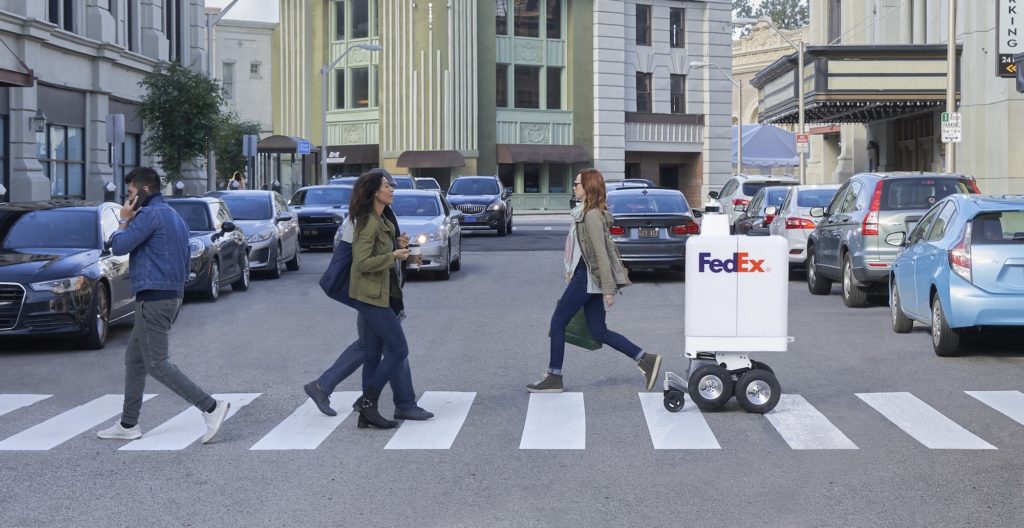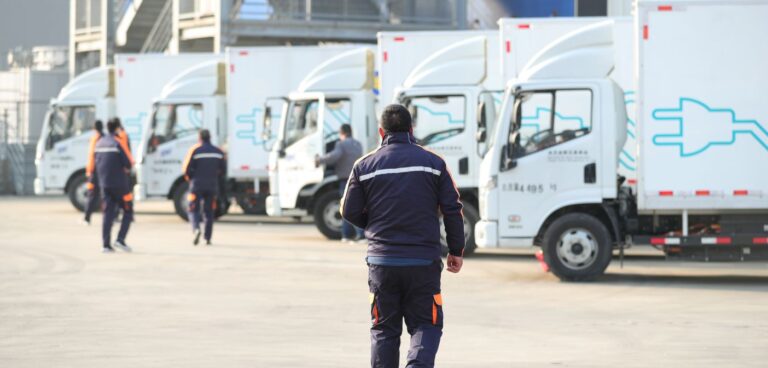Financial and environmental pressures, as well as changing consumer habits are impacting the logistics sector like never before. John Thornton speaks to leading figures to find out what the industry needs to do to ensure it not only survives but thrives in today’s challenging urban landscapes…
According to a report from the World Economic Forum and the World Business Council for Sustainable Development, the number of delivery vehicles in the top 100 cities globally will increase by 36% until 2030. Consequently, the report states that emissions from delivery traffic will increase by 32% and congestion will rise by over 21%, equalling an additional 11 minutes of commute time for each passenger every day.
Combine those statistics with the outcome of a study by the United Nations, which estimates that two-thirds of the world’s population will be living in cities by 2050, along with the fact that one in seven purchases worldwide are now made online – making e-commerce a £2.66tn industry, rising by more than a fifth every year – and it appears that the logistics sector is facing its busiest and most challenging period yet.
Indeed, how businesses tasked with transporting goods to, from and within cities, do so in ways that not only meet consumer expectations for the fast and convenient, but also adhere to increasingly stringent government-mandated environmental regulations, all without obliterating already wafer-thin margins, is provoking much thought throughout the industry on how to adapt successfully.

Trevor Hoyle, senior vice president, ground operations Europe, FedEx Express, believes implementing smarter transport solutions can play a significant role in balancing these conflicting demands. “Electric vehicles have reached an important milestone with the technology recently becoming commercially viable, but the electrification of vehicles is only one small step onto the road of change,” says Hoyle. “The innovations that accompany battery-powered vehicles offer significant opportunity for the logistics sector.”
According to Hoyle, automated vehicles have the potential to increase productivity by freeing drivers up by as much as 225 hours a year each. “For logistics operators, this will help ease the challenges faced by a growing driver skills shortage, while for existing drivers, it means they can acquire new skills associated with managing connected and automated [CAM] vehicle networks.
“By being connected through smart technology, CAM vehicles share data on road networks that will not only lead to road safety improvements, but will also increase efficiencies in route planning, vehicle deployment, capacity optimisation and fuel/energy utilisation,” says Hoyle.
However, he identifies last-mile congestion as a key issue that connected and electric vehicles can only go some way to alleviating before they start contributing to it, and thus suggests that “as many as 95% of city centre deliveries could be fulfilled by e-bikes” to, reduce demand on road and parking space, as well as congestion.
To steer logistics through the transition to a completely smart transport, Hoyle believes planning, design and access to charging infrastructure all need to be considered as part of a holistic solution to this shared challenge.
“If the wrong decisions are made and there is no provision for logistics, we could end up with a patchwork of experiments and compromises that may undermine the fundamental goal,” warns Hoyle. “Technology is advancing, but to ensure we do not lose momentum, government and industry must co-operate to ensure the right support structures – investment, regulations, legislation and trials, are in place to keep logistics moving.”

Location, location, location
Echoing Hoyle’s sentiment is Natalie Chapman, head of urban policy at the FTA, who argues that urban warehousing is just as vital as technology to keeping Britain trading speedily and sustainably. “Global demand for residential land in urban areas is skyrocketing, pushing the industrial land needed for warehousing and logistics to the outskirts of cities and beyond,” she explains.
For example, to accommodate London’s growing population, Savills has estimated that 66,000 homes a year need to be built in the capital city alone. And, despite 65% of the UK’s economy being driven by commerce, a Greater London Authority report notes that residential values in London are estimated to be an average of 3.2 times higher than industrial land values.
“This challenge is not exclusive to London; the same problem is occurring across all UK cities,” claims Chapman. “But there is a direct correlation between increasing urban population, and the rising demand for goods, which means logistics must be allocated sufficient space to support this increase and to service the growing population.”
Without it, Chapman asserts that journey times and distances for those involved in the supply chain servicing UK cities are increasing.
To combat the challenge of delivering the same number of items within the same time frame, across a longer distance, some in the industry have reacted by putting more vehicles on the road. However, in congested cities, not only is journey time reliability impacted, but the solution is dealing with the congestion problem by adding to it.
According to Chapman, one way to tackle the shortage of logistics land is to build upwards. Multi-storey warehousing is well established in cities where space is severely under pressure such as Tokyo, Singapore and Hong Kong. More recent examples have emerged in Germany and France although they have been slow to catch on in the UK as “the solution comes at a cost and industry alone will not be able to shoulder paying the premium”.
Though based on the outskirts of London, the multi-storey Heathrow Consolidation Centre (HCC) could provide a model for inner city industrial developers to follow, says Paul Durkin, director of home and e-fulfilment at Wincanton. “Urban consolidation for onward deliveries has been a topic of conversation for many years, and we are seemingly little closer to a satisfactory solution. However, all retail deliveries at Heathrow are mandated via its consolidation centre so anyone servicing the airport must incorporate this activity in its operational and commercial plans. What the HCC has achieved is a greater control of vehicle and goods flow, with higher standards of compliance.”
According to Durkin, the urban retail landscape is changing fast as traditional shopping centres are struggling to serve their core purpose. “This creates an opportunity for urban consolidation, utilising existing real estate and repurposing to support customer fulfilment alongside expanded entertainment experiences,” he explains.
Another key challenge is coming from the end customer. In an increasingly online world of shopping, home delivery is more prominent than ever in urban areas, believes Durkin. “We have seen a huge trend toward speed in recent years and next day delivery is still prevalent for smaller items bought online. What is developing in urban areas, however, is a greater move towards convenience.”
Indeed, the meteoric rise of internet shopping is ushering in an era of unprecedented change in the logistics industry. Angela Hultberg, head of sustainable mobility at Ingka Group – the largest IKEA franchisee with 375+ stores across 30 markets – believes e-commerce could be a force for good, leading to lower environmental impact as customers shop from their homes rather than going in a car to compare offers between stores.

However, she’s not without her doubts. “Using home deliveries instead of each customer going by car to pick up their goods can certainly be more sustainable, especially if considering electric vehicles, consolidation and route optimisation. But is that really what is happening?
“Customers expect deliveries to be fast, cheap – or free – and convenient. Even returns should be free. But what does this mean for the footprint of e-commerce? Are we setting up a system where we not only miss out on the potential environmental benefits from e-commerce, but are in fact creating even bigger problems?”
Though Hultberg concedes that retailers are partly responsible for creating this potentially perilous level of expectation, she’s quick to point out the measures industry can take to reduce any negative impact. “At IKEA we already offer 100% electric home deliveries in Shanghai and expect to have 100% electric or zero-emission capable deliveries globally by 2025. We’re also incorporating bike deliveries, lockers and barge in our logistics setup.
“None of this we do alone. It’s about challenging our own ways of working and finding the right partners to collaborate with. Retailers cannot keep delivering goods in the same way we did 20 years ago when the world around us has drastically changed. We must take this opportunity to do better.”
FedEx’s Trevor Hoyle agrees: “Logistics services will play an important role in shaping the smart transportation and infrastructure landscape. The argument for logistics to be considered an essential service is getting louder and harder to ignore. Issues around sustainability are bigger than ourselves, but smart transport solutions will make a positive difference.”
Society is currently experiencing the most unprecedented period in a generation due to Covid-19. However, with all the uncertainty that comes with a global pandemic, its clear that urban logistics will continue to develop at pace as economic, social and environmental pressures influence government and local authority policy. And the consequent pressures that unfold should support the need to build on this new era, enabling logistics outfits survive and thrive in the years ahead.
This article originally appeared in the June 2020 issue of CiTTi Magazine





